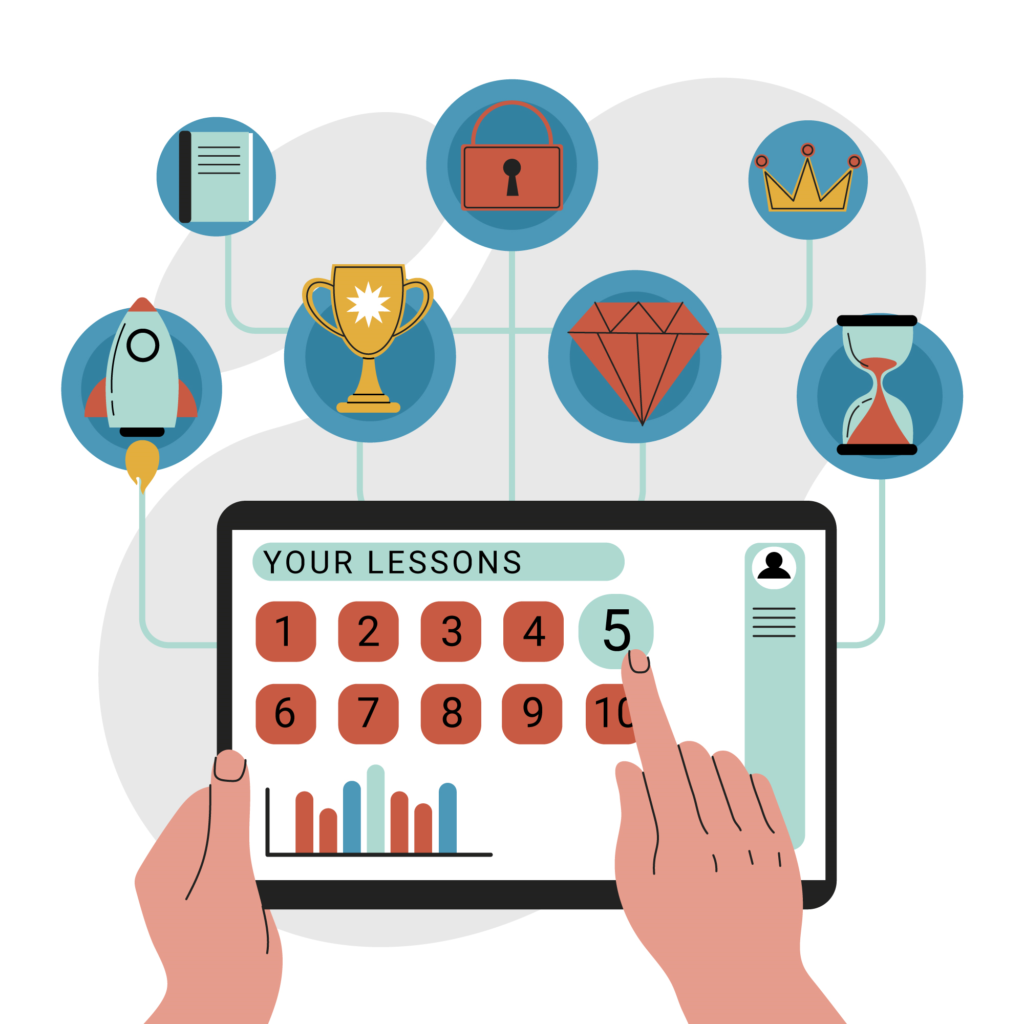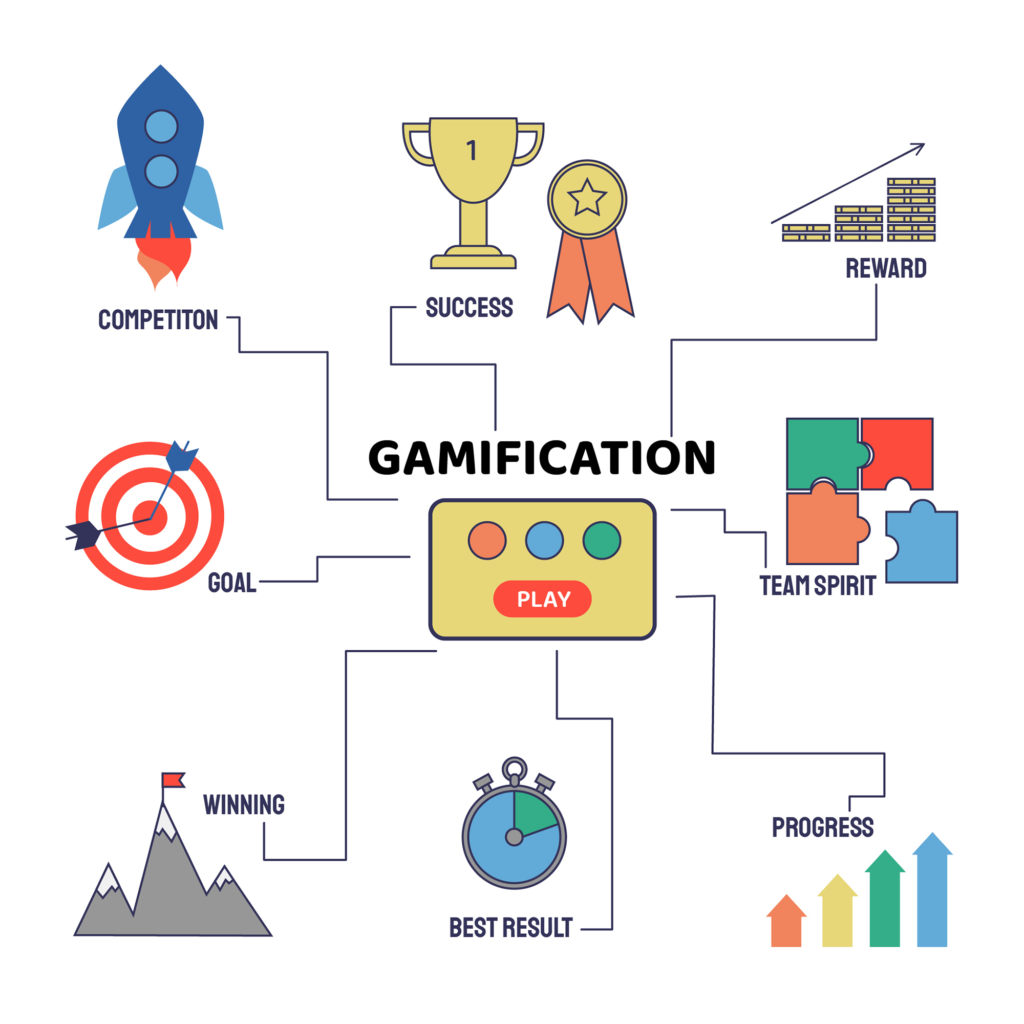As a game developer or business strategist, you’ve probably heard of gamification points.
What are the gamification points? They are the backbone of any successful gaming or gamification strategy, designed to push players to engage in desired behavior and improve their skills. Understanding how they work can help you create a more immersive and successful gaming experience.
However, it’s crucial to ensure that the point system is clear, achievable, and rewarding.
This article will explain what gamification points are, giving you the knowledge and tools you need to create an effective point system.
What Are Point Systems in Games
You’ve probably noticed that as you play your favorite video game, you’re constantly earning points. But have you ever stopped to think about what these game elements really mean and how they’re shaping your gaming experience?

These experience points are part of a cleverly designed point system woven into the fabric of the game to guide you, motivate you, and make the experience more engaging. They serve as a real-time feedback mechanism, instantly letting you know whether you’re succeeding or failing in your quests.
Each point you earn is a testament to your skill, strategy, and perseverance.
In essence, point systems in video games are a measure of your success. They’re not just about keeping score; they’re about progression, development, and achievement. As you accumulate more points, you’re not just boosting your score, you’re upgrading your avatar, unlocking new abilities, and gaining access to new challenges.
This evolution not only enhances your gaming experience but also fuels your motivation to dive deeper into the game world. It’s a brilliant blend of technical knowledge, creativity, and a deep understanding of player psychology that makes these point systems such a vital component of video gaming.
What Are Point Systems in Gamification?
In the exhilarating race of digital engagement, virtual scores serve as the fuel propelling users to sprint ahead, amassing rewards for their actions much like a seasoned gamer would in a virtual realm. This is what we call the gamification point system. It’s a clever tool that borrows from the gaming world, wherein points are awarded for specific actions or achievements, making things more fun but also boosting motivation.
Adding game-like elements can be used to mark user’s progress, incentivize correct answers, or even unlock premium content. They can be a means for your users to flaunt their prowess or a mechanism of increasing engagement of your users in a more meaningful way.

The key to a successful gamification point system lies in its ability to motivate users. It’s that alluring promise of a higher level or an exclusive reward that keeps them going.
But remember, it’s not just about doling out points. The points must lead to something specific, something that resonates with your users.
This way, you’re not just creating a point system but an experience, a journey that’s both rewarding and engaging. To make this process much simpler, we encourage you to try out our platform, where you can create engaging activities and reap the benefits!
What Factors To Consider When Creating a Point System?
Crafting an effective point system requires careful consideration of several factors.
Firstly, you should align the points with the learning objectives. A well-designed system makes each point meaningful and directly related to the knowledge or skill being taught. For example, in a game designed to educate about diabetes, points could be earned by correctly identifying foods that help manage blood sugar levels.
Another key factor is the use of diminishing time or loss aversion. Players could lose points if they take too long to answer a question or make incorrect choices, which intensifies the challenge and motivates them to improve.
Furthermore, a sense of adventure and exploration can be built into the gamified point system. This can be achieved by creating levels or stages that players unlock as they accumulate points. Each level can introduce new challenges or information, maintaining interest and encouraging continued engagement.
The point system should also promote collaboration and connection. For instance, points could be awarded for teamwork or successful collaboration.
Ultimately, adding game-like elements should enhance the player’s experience while effectively communicating the progress. Remember, the goal is not merely to award points but to create a system that motivates, educates, and engages.
What Are the Examples of Point Reward Programs?
Ever considered how popular businesses successfully keep their customers coming back for more? Let’s delve into some interesting examples of point reward programs.
Starbucks
Starbucks, a global leader in the coffee industry, has an effective reward system in place. They’ve created the Starbucks Rewards program, where customers earn points, or ‘Stars’ for every dollar spent. These Stars can be redeemed for free drinks, food, and more. The more you spend, the more Stars you earn, and the more rewards you can redeem, thus encouraging customers to make more frequent and pricier purchases.
Marriott Bonvoy
Another example is the Marriott Bonvoy rewards program. This hotel chain’s reward system allows guests to earn points for every dollar spent on hotel stays, dining, and other experiences. The points can then be redeemed for free hotel stays, room upgrades, and other exclusive benefits.
Southwest Airlines
Lastly, let’s consider the popular airline company, Southwest Airlines. With their Rapid Rewards program, passengers earn points for each flight taken and can use these points for future flight bookings, seat upgrades, and more. Each of these programs showcases how point reward systems can effectively drive customer loyalty, retention, and overall business growth in everyday life.
In understanding these examples, you can see the importance of balancing the need for customer engagement with the psychology of reward anticipation. The design of these programs has been tailored to not only encourage repeat purchases but also to create a sense of achievement and loyalty among loyal customers.
This understanding of player psychology, coupled with technical knowledge and creativity, is the key to creating an effective and successful points reward system.
How Are Gamification Points Beneficial?
You might wonder how incorporating game elements into non-game contexts can be beneficial, right? Well, gamification points can be a game-changer in many ways.
By using points as a form of reward for completing actions, you can stimulate the desire for gratification in your users, clients, or students, making tasks more engaging. It’s a creative approach with no specific rules, allowing you to tailor your gamification strategy to your specific needs.
For example, if you’re in the sales industry, gamification mechanics can increase customer loyalty by making your clients feel appreciated and positively affecting your brand identity.
Gamification points can also make learning experiences more exciting and motivating. By tracking progress and offering the possibility to unlock premium content, points can make even the most daunting tasks in real-life seem achievable.
For example, if you’re developing an app, consider using gamification points to increase user engagement. For instance, fitness apps can incentivize users to reach their weight loss goals by breaking them down into small, point-rewarding tasks. Not only does this method make the process more fun, but it also helps identify engagement patterns and incentivize social activity.
So, whether you’re looking to boost sales, improve education, or drive app engagement, gamification points can offer a powerful solution.
What Is the Psychological Impact of Points on Users?
Game design elements such as gamification points can have a profound psychological impact on users. They tap into your intrinsic motivation, driving you to engage more with the platform or task at hand.
The more points you earn, the more you feel a sense of accomplishment, which can increase your satisfaction. They play on the human tendency to compete, leading you to strive to outperform others and yourself. This competition can lead to increased engagement, productivity, and learning in non-game contexts.
Moreover, they offer you tangible evidence of your progress, fostering a sense of forward momentum and achievement. This sense of progress can motivate you to persevere and work harder, even when faced with challenging tasks.
How To Implement Gamification Points Effectively?
Implementing gamification points effectively requires careful planning and execution. Here are some tips to make the most of gamification elements:
1. Identify your goals: Understand what you want to achieve using gamification points. Whether it’s inciting user engagement, boosting sales, or improving knowledge retention, clarifying your objectives can help inform your gamification strategy.
2. Define your point system: Decide how actions or achievements will be awarded with points. Will points be given for every action taken, or only for specific achievements? Define the criteria of the point system used to reward users clearly to ensure they understand how to earn the points.
3. Balance challenge and reward: Make sure to strike a balance between challenging tasks and rewarding achievements. Too challenging, and users can feel discouraged; too easy, and they may lose interest. Find the sweet spot to keep them motivated to engage in the desired behavior.
4. Be consistent: Ensure that your point system remains consistent. Randomly changing the point values or the criteria for earning them can confuse users and reduce the effectiveness of the point system.
5. Offer meaningful rewards: The rewards for earning points need to be meaningful to your users. Whether it’s unlocking premium content, access to new features, or physical goods and perks, rewards should align with your users’ interests and desires.
By keeping these factors in mind, you can effectively implement gamification points and maximize their potential benefits.
Applications of Gamification Points in Various Industries
The application of game mechanics, such as gamification points spans across multiple industries, as many businesses have recognized the benefits of incorporating game mechanics into their operations. Let’s delve into how implementation of gamification techniques in various sectors can be beneficial
1. Education: Gamification points are employed in educational platforms to motivate students and increase engagement. For example, language learning apps, like Duolingo, offer points for completing lessons and meeting daily targets.
2. Sales: In the sales industry, gamification points are being used to incentivize employees and drive sales growth. For instance, sales representatives can earn points for every deal closed, and these points can be redeemed for rewards or perks. This not only encourages friendly competition among team members but also helps in boosting overall performance and productivity.
3. Workplace: Companies are introducing gamification points in the workplace as well to enhance employee motivation and job satisfaction. Employees can earn points for accomplishing tasks, meeting project deadlines or for innovative ideas. The accumulation of these points can lead to rewards or recognition, fostering a positive and engaging work environment.
4. Therapies: In the field of therapies, especially psychological and physical, game design elements are being used in rehabilitation exercises and treatment plans. Patients can earn points by adhering to their therapy schedules, completing therapeutic tasks or attaining therapy goals. These points serve as a motivational tool, making the therapy process more engaging and enjoyable for patients.
5. Training: Training programs, whether it’s for new hires or ongoing employee development, are utilizing gamification points to enhance learning retention and participation. Training participants can earn points for completing modules, participating in discussions, or achieving high scores in post-training evaluations. Such implements of game elements can make the learning process more interactive and effective.
6. Business: Gamification points are also playing a significant role in the overall business strategy. Many businesses are applying gamification tactics to their customer loyalty programs; customers can earn points for their purchases, which can be redeemed for discounts or free products. This not only boosts customer engagement but also encourages repeat business and customer loyalty. Moreover, gamification points can also be used in a business marketing strategy to promote brand awareness and customer interaction.
Incorporating gamification points in these sectors has shown to be quite successful, enhancing user engagement, boosting sales and loyalty, and creating an overall positive user experience.
Conclusion
In essence, gamification points are a powerful tool to engage, motivate, and reward users. They’re not just about scoring high in a game, but about fostering user interaction and achieving set objectives.
When designed well, gamification elements can truly transform user experience.
Remember, effective point systems are those that understand player psychology. They tap into our innate desire for achievement, progress, and competition.
So, whether you’re a game designer or a business owner, gamification points can be your secret weapon to success.

